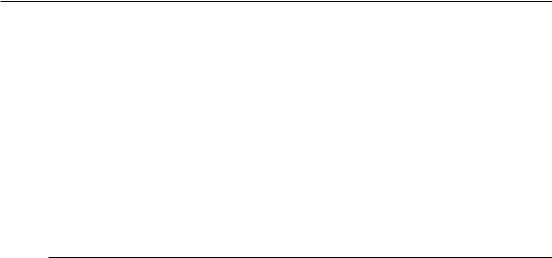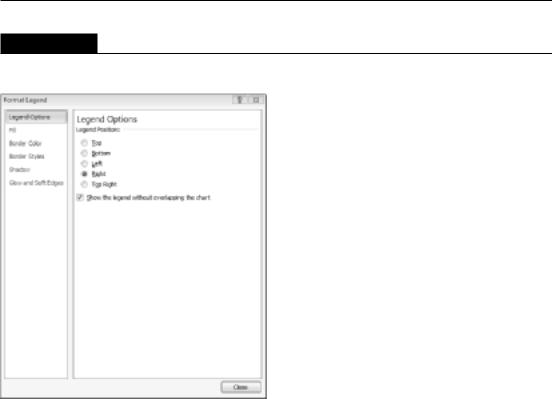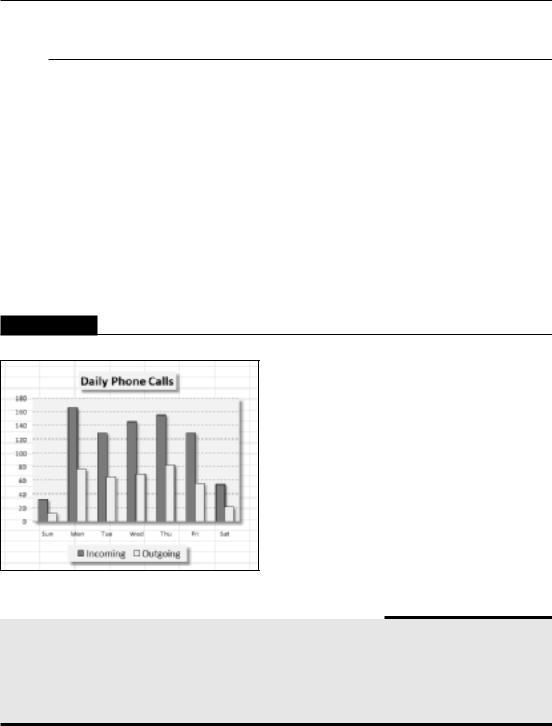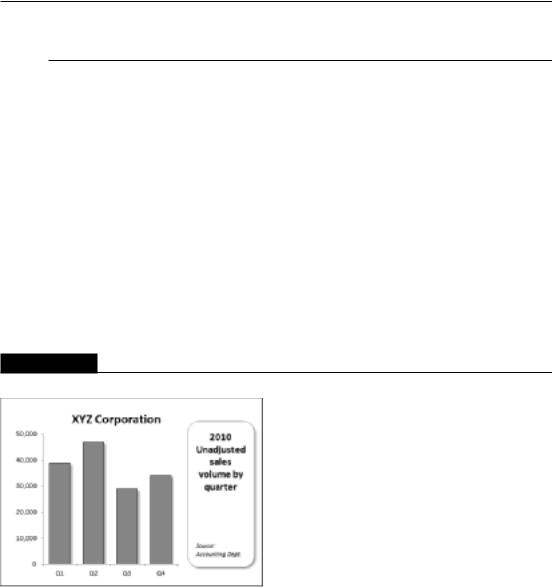
- •About the Author
- •About the Technical Editor
- •Credits
- •Is This Book for You?
- •Software Versions
- •Conventions This Book Uses
- •What the Icons Mean
- •How This Book Is Organized
- •How to Use This Book
- •What’s on the Companion CD
- •What Is Excel Good For?
- •What’s New in Excel 2010?
- •Moving around a Worksheet
- •Introducing the Ribbon
- •Using Shortcut Menus
- •Customizing Your Quick Access Toolbar
- •Working with Dialog Boxes
- •Using the Task Pane
- •Creating Your First Excel Worksheet
- •Entering Text and Values into Your Worksheets
- •Entering Dates and Times into Your Worksheets
- •Modifying Cell Contents
- •Applying Number Formatting
- •Controlling the Worksheet View
- •Working with Rows and Columns
- •Understanding Cells and Ranges
- •Copying or Moving Ranges
- •Using Names to Work with Ranges
- •Adding Comments to Cells
- •What Is a Table?
- •Creating a Table
- •Changing the Look of a Table
- •Working with Tables
- •Getting to Know the Formatting Tools
- •Changing Text Alignment
- •Using Colors and Shading
- •Adding Borders and Lines
- •Adding a Background Image to a Worksheet
- •Using Named Styles for Easier Formatting
- •Understanding Document Themes
- •Creating a New Workbook
- •Opening an Existing Workbook
- •Saving a Workbook
- •Using AutoRecover
- •Specifying a Password
- •Organizing Your Files
- •Other Workbook Info Options
- •Closing Workbooks
- •Safeguarding Your Work
- •Excel File Compatibility
- •Exploring Excel Templates
- •Understanding Custom Excel Templates
- •Printing with One Click
- •Changing Your Page View
- •Adjusting Common Page Setup Settings
- •Adding a Header or Footer to Your Reports
- •Copying Page Setup Settings across Sheets
- •Preventing Certain Cells from Being Printed
- •Preventing Objects from Being Printed
- •Creating Custom Views of Your Worksheet
- •Understanding Formula Basics
- •Entering Formulas into Your Worksheets
- •Editing Formulas
- •Using Cell References in Formulas
- •Using Formulas in Tables
- •Correcting Common Formula Errors
- •Using Advanced Naming Techniques
- •Tips for Working with Formulas
- •A Few Words about Text
- •Text Functions
- •Advanced Text Formulas
- •Date-Related Worksheet Functions
- •Time-Related Functions
- •Basic Counting Formulas
- •Advanced Counting Formulas
- •Summing Formulas
- •Conditional Sums Using a Single Criterion
- •Conditional Sums Using Multiple Criteria
- •Introducing Lookup Formulas
- •Functions Relevant to Lookups
- •Basic Lookup Formulas
- •Specialized Lookup Formulas
- •The Time Value of Money
- •Loan Calculations
- •Investment Calculations
- •Depreciation Calculations
- •Understanding Array Formulas
- •Understanding the Dimensions of an Array
- •Naming Array Constants
- •Working with Array Formulas
- •Using Multicell Array Formulas
- •Using Single-Cell Array Formulas
- •Working with Multicell Array Formulas
- •What Is a Chart?
- •Understanding How Excel Handles Charts
- •Creating a Chart
- •Working with Charts
- •Understanding Chart Types
- •Learning More
- •Selecting Chart Elements
- •User Interface Choices for Modifying Chart Elements
- •Modifying the Chart Area
- •Modifying the Plot Area
- •Working with Chart Titles
- •Working with a Legend
- •Working with Gridlines
- •Modifying the Axes
- •Working with Data Series
- •Creating Chart Templates
- •Learning Some Chart-Making Tricks
- •About Conditional Formatting
- •Specifying Conditional Formatting
- •Conditional Formats That Use Graphics
- •Creating Formula-Based Rules
- •Working with Conditional Formats
- •Sparkline Types
- •Creating Sparklines
- •Customizing Sparklines
- •Specifying a Date Axis
- •Auto-Updating Sparklines
- •Displaying a Sparkline for a Dynamic Range
- •Using Shapes
- •Using SmartArt
- •Using WordArt
- •Working with Other Graphic Types
- •Using the Equation Editor
- •Customizing the Ribbon
- •About Number Formatting
- •Creating a Custom Number Format
- •Custom Number Format Examples
- •About Data Validation
- •Specifying Validation Criteria
- •Types of Validation Criteria You Can Apply
- •Creating a Drop-Down List
- •Using Formulas for Data Validation Rules
- •Understanding Cell References
- •Data Validation Formula Examples
- •Introducing Worksheet Outlines
- •Creating an Outline
- •Working with Outlines
- •Linking Workbooks
- •Creating External Reference Formulas
- •Working with External Reference Formulas
- •Consolidating Worksheets
- •Understanding the Different Web Formats
- •Opening an HTML File
- •Working with Hyperlinks
- •Using Web Queries
- •Other Internet-Related Features
- •Copying and Pasting
- •Copying from Excel to Word
- •Embedding Objects in a Worksheet
- •Using Excel on a Network
- •Understanding File Reservations
- •Sharing Workbooks
- •Tracking Workbook Changes
- •Types of Protection
- •Protecting a Worksheet
- •Protecting a Workbook
- •VB Project Protection
- •Related Topics
- •Using Excel Auditing Tools
- •Searching and Replacing
- •Spell Checking Your Worksheets
- •Using AutoCorrect
- •Understanding External Database Files
- •Importing Access Tables
- •Retrieving Data with Query: An Example
- •Working with Data Returned by Query
- •Using Query without the Wizard
- •Learning More about Query
- •About Pivot Tables
- •Creating a Pivot Table
- •More Pivot Table Examples
- •Learning More
- •Working with Non-Numeric Data
- •Grouping Pivot Table Items
- •Creating a Frequency Distribution
- •Filtering Pivot Tables with Slicers
- •Referencing Cells within a Pivot Table
- •Creating Pivot Charts
- •Another Pivot Table Example
- •Producing a Report with a Pivot Table
- •A What-If Example
- •Types of What-If Analyses
- •Manual What-If Analysis
- •Creating Data Tables
- •Using Scenario Manager
- •What-If Analysis, in Reverse
- •Single-Cell Goal Seeking
- •Introducing Solver
- •Solver Examples
- •Installing the Analysis ToolPak Add-in
- •Using the Analysis Tools
- •Introducing the Analysis ToolPak Tools
- •Introducing VBA Macros
- •Displaying the Developer Tab
- •About Macro Security
- •Saving Workbooks That Contain Macros
- •Two Types of VBA Macros
- •Creating VBA Macros
- •Learning More
- •Overview of VBA Functions
- •An Introductory Example
- •About Function Procedures
- •Executing Function Procedures
- •Function Procedure Arguments
- •Debugging Custom Functions
- •Inserting Custom Functions
- •Learning More
- •Why Create UserForms?
- •UserForm Alternatives
- •Creating UserForms: An Overview
- •A UserForm Example
- •Another UserForm Example
- •More on Creating UserForms
- •Learning More
- •Why Use Controls on a Worksheet?
- •Using Controls
- •Reviewing the Available ActiveX Controls
- •Understanding Events
- •Entering Event-Handler VBA Code
- •Using Workbook-Level Events
- •Working with Worksheet Events
- •Using Non-Object Events
- •Working with Ranges
- •Working with Workbooks
- •Working with Charts
- •VBA Speed Tips
- •What Is an Add-In?
- •Working with Add-Ins
- •Why Create Add-Ins?
- •Creating Add-Ins
- •An Add-In Example
- •System Requirements
- •Using the CD
- •What’s on the CD
- •Troubleshooting
- •The Excel Help System
- •Microsoft Technical Support
- •Internet Newsgroups
- •Internet Web sites
- •End-User License Agreement

Chapter 19: Learning Advanced Charting
Note
When a single data point is selected, the Chart Element control will display the name of the selected element even though it’s not actually available for selection from the drop-down list. n
Tip
If you do a lot of work with charts, you may want to add the Chart Element control to your Quick Access toolbar. That way, it will always be visible regardless of which Ribbon tab is showing. To add the control to your Quick Access toolbar, right-click the down arrow in the control and choose Add to Quick Access Toolbar. n
User Interface Choices for Modifying Chart Elements
You have three main ways of working with chart elements: the Format dialog box, the Ribbon, and the Mini toolbar.
Using the Format dialog box
When a chart element is selected, use the element’s Format dialog box to format or set options for the element. Each chart element has a unique Format dialog box that contains controls specific to the element (although many Format dialog boxes have controls in common). To access the Format dialog box, use any of these methods:
•Double-click the chart element.
•Right-click the chart element and then choose Format xxxx from the shortcut menu (where xxxx is the name of the element).
•Select a chart element and then choose Chart Tools Format Current Selection Format Selection.
•Select a chart element and press Ctrl+1.
Any of these actions displays a tabbed Format dialog box from which you can make many changes to the selected chart element. For example, Figure 19.3 shows the dialog box that appears when a chart’s legend is selected.
Tip
The Format dialog box is a modeless dialog box, so you can leave it open while you’re working on a chart. If you select a different chart element, the Format dialog box changes to display the options appropriate for the new element. n
441

Part III: Creating Charts and Graphics
FIGURE 19.3
Use the Format dialog box to set the properties of a selected chart element — in this case, the chart’s legend.
Using the Ribbon
When a chart element is selected, you can also use the commands on the Ribbon to change some aspects of its formatting. For example, to change the color of the bars in a column chart, use the commands from the Chart Tools Format Shape Styles group. For some types of chart element formatting, you need to leave the Chart Tools tab. For example, to adjust font-related properties, use the commands from the Home Font Group.
The Ribbon controls do not comprise a comprehensive set of tools for chart elements. The Format dialog box usually presents options that aren’t available on the Ribbon.
Using the Mini toolbar
When you right-click an element in a chart, Excel displays a shortcut menu and the Mini toolbar. The Mini toolbar contains commonly used formatting commands, plus a copy of the Chart Elements control (which you can use to select another chart element).
Commands that are inappropriate for the selected chart element are disabled in the Mini toolbar. For example, if you select an element that doesn’t contain text, the text-related tools are disabled.
442

Chapter 19: Learning Advanced Charting
Modifying the Chart Area
The Chart Area is an object that contains all other elements in the chart. You can think of it as a chart’s master background or container.
The only modifications that you can make to the Chart Area are cosmetic. You can change its fill color; outline; or effects, such as shadow and soft edges.
Note that if you set the Chart Area of an embedded chart to use No Fill, the underlying cells are visible. Figure 19.4 shows a chart that uses No Fill and No Outline in its Chart Area. The Plot Area, Legend, and Chart Title do use a fill color. Adding a shadow to these other elements make them appear to be floating on the worksheet.
The Chart Area element also controls all the fonts used in the chart. For example, if you want to change every font in the chart, you don’t need to format each text element separately. Just select the Chart Area and then make the change from options of the Home Font group or by using the Mini toolbar.
FIGURE 19.4
The Chart Area element uses No Fill, so the underlying cells are visible.
Resetting Chart Element Formatting
If you go overboard formatting a chart element, you can always reset it to its original state. Just select the element and choose Chart Tools Format Current Selection Reset to Match Style. Or, rightclick the chart element and choose Reset to Match Style from the shortcut menu.
To reset all formatting changes in the entire chart, select the Chart Area before you issue the Reset to Match Style command.
443

Part III: Creating Charts and Graphics
Modifying the Plot Area
The Plot Area is the part of the chart that contains the actual chart. More specifically, the Plot Area is a container for the chart series.
Tip
If you set the Shape Fill property to No Fill, the Plot Area will be transparent. Therefore, the fill color applied to the Chart Area will show through. n
You can move and resize the Plot Area. Select the Plot Area and then drag a border to move it. To change the size of the Plot Area, drag one of the corner handles.
Different chart types vary in how they respond to changes in the Plot Area dimensions. For example, you can’t change the relative dimensions of the Plot Area of a pie chart or a radar chart. The Plot Area of these charts is always square. With other chart types, though, you can change the aspect ratio of the Plot Area by changing either the height or the width.
Figure 19.5 shows a chart in which the Plot Area was resized to make room for a Shape that contains text.
FIGURE 19.5
Reducing the size of the Plot Area makes room for the Shape.
In some cases, the size of the Plot Area changes automatically when you adjust other elements of your chart. For example, if you add a legend to a chart, the size of the Plot Area may be reduced to accommodate the legend.
444
